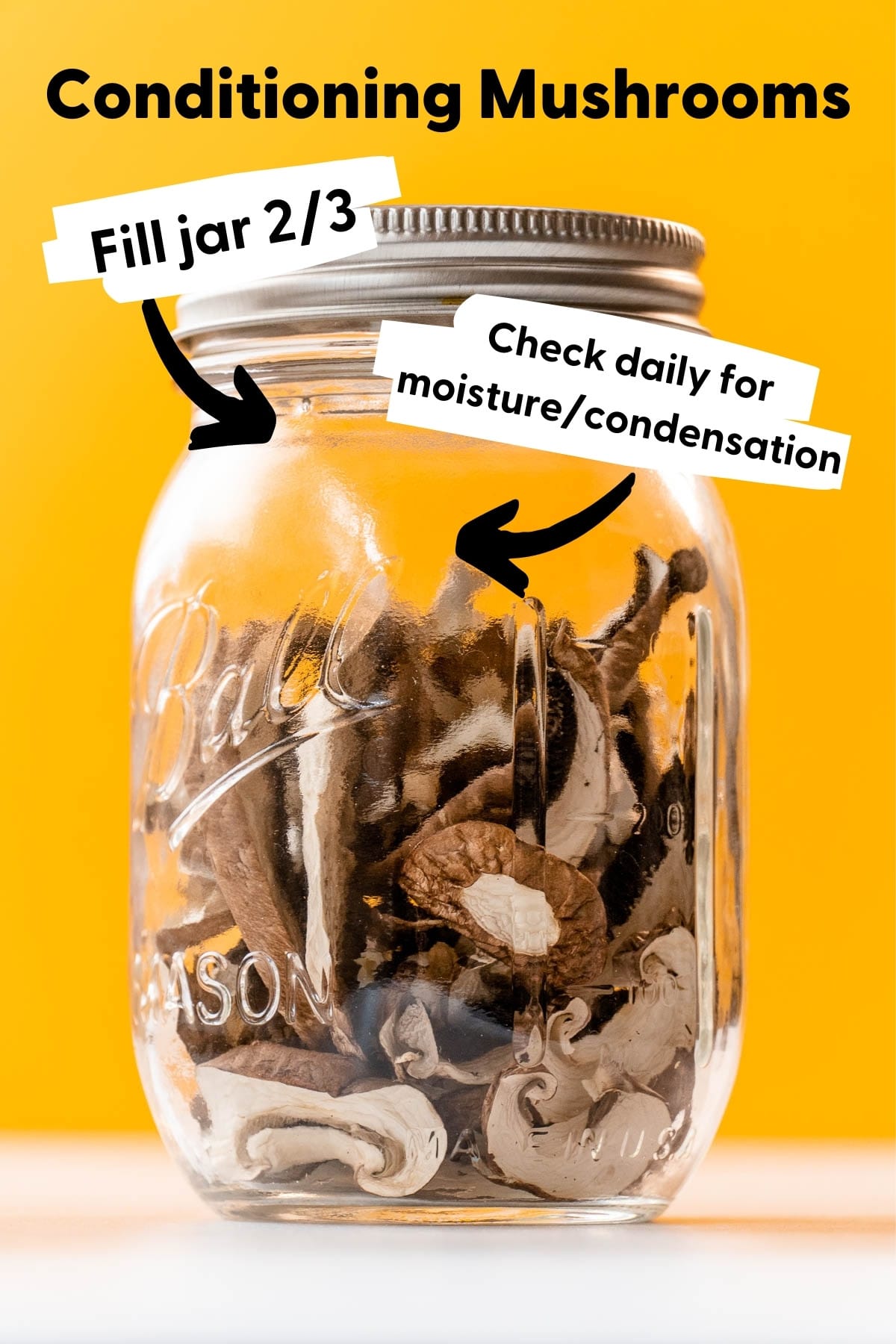How to Dehydrate Mushrooms
This post may contain affiliate links.
Dehydrated mushrooms are an incredibly versatile pantry item! Learn how easy it is to dehydrate your own mushrooms so you always have some on hand.

There is nothing more disappointing than spending money on “top-shelf” mushrooms only for them to go slimy in the back of your refrigerator.
That’s why it’s a great idea to start dehydrating your own mushrooms at home!
Dried mushrooms have a shelf life of a year or more, and after rehydrating, can be used just like fresh mushrooms. So you will always be able to add some extra umami flavor to any of your dishes.
While you can buy dry mushrooms from the store, it can be much cheaper to buy fresh mushrooms and dehydrate them yourself. Plus, you’ll have more variety to choose from!
Some of our favorite ways to use dehydrated mushrooms:
- Rehydrate and use in recipes either at home or in backpacking meals
- Water used to rehydrate is great for stocks, soups, risotto, etc.
- Dried mushrooms can be blitzed to make an umami rich mushroom powder
- Dried mushrooms can be shaved using a micro planer over pastas
So if you’re interested in dehydrating your own mushrooms, let’s get started!

What types of mushrooms can be dehydrated?
Any edible mushroom variety can be dehydrated. Crimini or baby bella, shiitake, portobello, button, chanterelle, porcini, oyster, etc.
The most important factor when selecting mushrooms is to use the freshest mushrooms possible! Mushrooms that are past their prime will not store as well and can start to smell “off” in your dehydrator.
To check for freshness, break the stem from the cap. You should feel (or even hear!) a bit of a “snap” when the stem breaks off (the exception is shiitakes–their stems are too tough for this test). If the mushroom feels rubbery or slimy, if it bends instead of breaks, or is starting to develop dark brown or black spots, that’s your sign that the mushrooms are not fresh enough to dehydrate.

Prepping mushrooms for drying
Before you start prepping your mushrooms, make sure your counters, equipment, and hands are clean & sanitized to prevent contamination, which can spoil your batch down the line.
- Clean the mushrooms: Use a damp kitchen towel to gently clean any dirt or grit off your mushrooms. Avoid washing with water—while this won’t harm your mushrooms, it can cause them to darken during the dehydrating process.
- Trim the stems: Remove any stems that are tough and stalky. (We save them to make veggie stock). You can then cut them off with a paring knife or tear them by hand.
- Slice the mushrooms: Using a sharp knife, cut the mushrooms into ¼” slices. Alternatively, you can dice the mushrooms into small pieces if that works better for your end use.

How to dry mushrooms
Dehydrating mushrooms is fairly simple and straightforward—a great ingredient for beginners! Once your mushrooms are prepped, set up your dehydrator and follow these steps:
- Arrange the mushrooms on your dehydrator trays. If you’re using a tray that has large holes, we recommend that you line it with parchment paper or, even better, a mesh liner cut to the size of your tray. Leave space between the pieces to allow air to circulate.
- Dehydrate at 125ºF (52ºC) for 3-8 hours until the mushrooms are brittle—they should break, not bend.
- Depending on your machine, you may need to rotate the trays every so often to promote even drying.
- Dehydrating using an oven: Place the mushrooms in a single layer on a lined baking sheet. Dry in the oven on its lowest temperature setting—if possible, keep the door propped open to allow steam to escape. Flip the pieces over every hour and remove as soon as they are completely dry.
Equipment Spotlight: Dehydrators
If you’re in the market for a dehydrator, we recommend buying one with an adjustable temperature. This will allow you to dial in the drying temp to give you the best results for individual ingredients. The dehydrator we recommend (and use) most often is the COSORI dehydrator. You can also check out our best dehydrators post for a comparison of all the dehydrators we’ve used and would recommend.
How to tell when mushrooms are done
Mushrooms should be brittle when they are completely dried. To test, let them cool, then break a few pieces. If they break easily, they are done. If the slices bend, put them back into the dehydrator or oven to dry longer.

Conditioning
To condition your mushrooms, let them cool completely and then place them in a large airtight container (like a mason jar), seal, and leave it on your counter for a few days. Check it daily to make sure that there’s no moisture/condensation forming on the sides of the jar, and shake the contents to make sure they aren’t sticking together.
If you do notice that there is condensation, you can put it back into the dehydrator to dry for longer (so long as there is no mold growing).
After a week, if there are no signs of moisture or mold, you can package your mushrooms for long-term storage.

How to store
When properly dried and stored, dehydrated mushrooms can last a year or more. Here are our tips for storage:
- Let the mushrooms cool completely before transferring them.
- Don’t skip the conditioning step! Even a little moisture can reduce shelf life or ruin an entire batch.
- Store in a clean, airtight container. For longer shelf life, vacuum seal.
- Use a moisture absorbing desiccant packet if you anticipate opening the container often, or if you live in an area with high humidity.
- Label the container with the date and any other important details.
- Place the container in a cool, dark, and dry place—inside of a pantry cabinet works well.
Vacuum Sealing Tips
We like to store our dehydrated food in mason jars that have been vacuum-sealed using this handheld FoodSaver vacuum sealer along with these jar sealing attachments. This gives us the benefit of vacuum sealing without the waste (and expense) of plastic vacuum sealing bags. Since the jars are clear we make sure we store them in a dark spot in our pantry to keep them out of direct light.

How to use
To rehydrate mushrooms, place them in a bowl and cover them with boiling water and allow them to rehydrate for about 30 minutes. Or, you can simmer them in a small pot to speed up the process a bit. You’ll know they are rehydrated when they lose any rubbery texture.
Dehydrated mushrooms are an awesome ingredient to have on hand in your pantry or to use in backpacking and camping meals. Here are some of the ways to use them:
- Put them in a blender and turn them into a powder to add an umami punch to any savory dish—or use in marinades or dry rubs
- Add to soups or stews
- Use in stir-frys
- Add to risotto
- Use to make mushroom gravy
- Incorporate into pasta sauce
- Add them to your stock pot when making vegetable broth for extra flavor
- Use them in these backpacking/camping meals:
Fresh to dehydrated conversion
½ pound (8 oz) fresh = .75 oz / 21 g dehydrated
1 pound (16 oz) fresh = 1½ oz / 42 g dehydrated

Dehydrated Mushrooms
Equipment
- Airtight storage container
- Vacuum sealer (optional)
Ingredients
- Fresh mushrooms
Instructions
- Start with clean hands, equipment, and countertops.
- Clean mushrooms with a kitchen towel, brushing off any dirt or grit.
- Cut mushrooms into ¼” slices or pieces.
- Arrange mushrooms in a single layer on dehydrator trays, ensuring there is space between pieces to allow airflow.
- Dehydrate at 125F/52C for 3-8 hours*, until the mushrooms are completely dry. They should be brittle and break, not bend, when fully dry.
- Store in an airtight container in a cool, dark place for up to a year. Optionally, place a moisture absorber in the container if you will open it often or live in a humid area.

